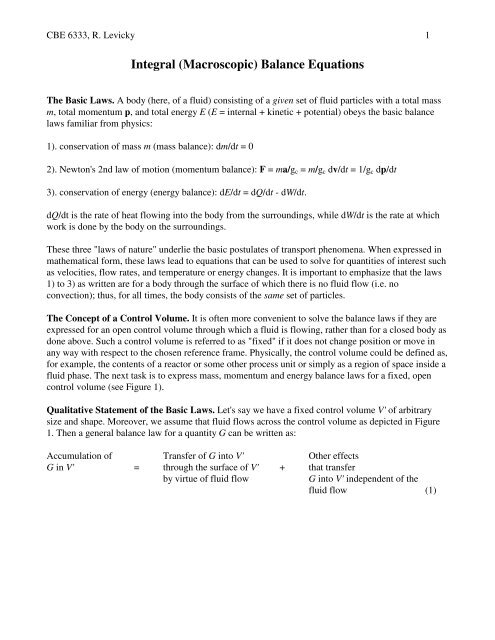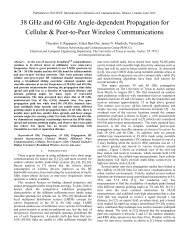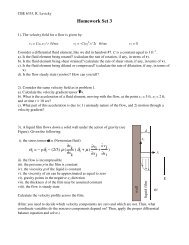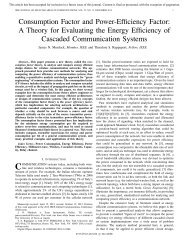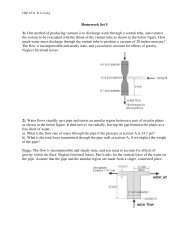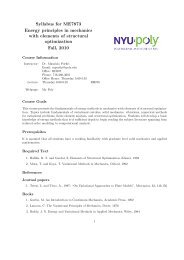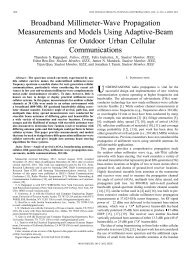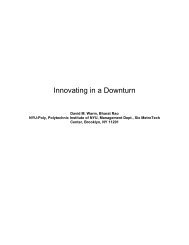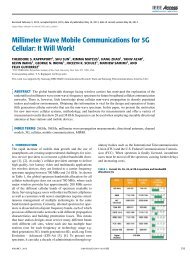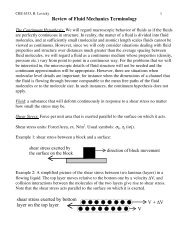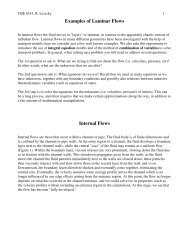Integral (Macroscopic) Balance Equations
Integral (Macroscopic) Balance Equations
Integral (Macroscopic) Balance Equations
Create successful ePaper yourself
Turn your PDF publications into a flip-book with our unique Google optimized e-Paper software.
CBE 6333, R. Levicky 1<br />
<strong>Integral</strong> (<strong>Macroscopic</strong>) <strong>Balance</strong> <strong>Equations</strong><br />
The Basic Laws. A body (here, of a fluid) consisting of a given set of fluid particles with a total mass<br />
m, total momentum p, and total energy E (E = internal + kinetic + potential) obeys the basic balance<br />
laws familiar from physics:<br />
1). conservation of mass m (mass balance): dm/dt = 0<br />
2). Newton's 2nd law of motion (momentum balance): F = ma/g c = m/g c dv/dt = 1/g c dp/dt<br />
3). conservation of energy (energy balance): dE/dt = dQ/dt - dW/dt.<br />
dQ/dt is the rate of heat flowing into the body from the surroundings, while dW/dt is the rate at which<br />
work is done by the body on the surroundings.<br />
These three "laws of nature" underlie the basic postulates of transport phenomena. When expressed in<br />
mathematical form, these laws lead to equations that can be used to solve for quantities of interest such<br />
as velocities, flow rates, and temperature or energy changes. It is important to emphasize that the laws<br />
1) to 3) as written are for a body through the surface of which there is no fluid flow (i.e. no<br />
convection); thus, for all times, the body consists of the same set of particles.<br />
The Concept of a Control Volume. It is often more convenient to solve the balance laws if they are<br />
expressed for an open control volume through which a fluid is flowing, rather than for a closed body as<br />
done above. Such a control volume is referred to as "fixed" if it does not change position or move in<br />
any way with respect to the chosen reference frame. Physically, the control volume could be defined as,<br />
for example, the contents of a reactor or some other process unit or simply as a region of space inside a<br />
fluid phase. The next task is to express mass, momentum and energy balance laws for a fixed, open<br />
control volume (see Figure 1).<br />
Qualitative Statement of the Basic Laws. Let's say we have a fixed control volume V' of arbitrary<br />
size and shape. Moreover, we assume that fluid flows across the control volume as depicted in Figure<br />
1. Then a general balance law for a quantity G can be written as:<br />
Accumulation of Transfer of G into V' Other effects<br />
G in V' = through the surface of V' + that transfer<br />
by virtue of fluid flow<br />
G into V' independent of the<br />
fluid flow (1)
CBE 6333, R. Levicky 2<br />
Fluid<br />
Flow<br />
x 3<br />
x 2<br />
x 1<br />
Fig. 1<br />
V'<br />
Here, G is one of the three quantities of interest: total mass, momentum, or energy. Let's rephrase<br />
equation (1) to reflect these selections of G.<br />
If G is total mass, then:<br />
Accumulation of transfer of mass into V' by fluid<br />
mass in V' = flow across the surface of V' + 0 (no other effects) (2)<br />
The external effects for mass transfer are zero because mass can only be transferred by virtue of the<br />
fluid flow. When something is transferred by virtue of fluid flow, we say that it is transferred by<br />
"convection." If no fluid flow occurs across the surface of V' (i.e. if there is no convection), then no<br />
mass is transferred into V'.<br />
If G is momentum, then (G is bold since momentum is a vector)<br />
Accumulation of transfer of momentum transfer (generation) of<br />
momentum in V' = into V' by fluid flow + momentum in V' due to forces<br />
across the surface of V' acting on V' (3)<br />
Momentum is transferred by convection (1st term on right) because the fluid that enters V' brings<br />
momentum with it. For example, if a 1 kg piece of fluid moving at a velocity of 2 δ x m/s enters V', then<br />
2 δ x kg m/s of momentum was brought into V' since the momentum p of the piece of fluid is p = mv =<br />
2 δ x kg m/s. The basis vector δ x indicates that the momentum brought into V' is along the direction of<br />
the x axis. The second term on the right of equation (3) is present because forces acting on the volume<br />
V' will impart momentum to the fluid contained in V' according to Newton's 2nd law, F = 1/g c dp/dt.<br />
The force term will be discussed in greater detail below.<br />
If G is energy, then<br />
Accumulation of transfer of energy transfer of energy into<br />
energy in V' = into V' by fluid flow + V' by heat transfer and by work (4)<br />
across the surface of V'
CBE 6333, R. Levicky 3<br />
Energy is transferred by convection (1st term on right) because the fluid that enters V' brings energy<br />
with it. Due to its nonzero velocity, the fluid possesses kinetic energy. Due to its position in a<br />
gravitational field (and / or other potential fields, such as electric or magnetic), the fluid possesses<br />
potential energy. Due to the molecular bond vibration, rotation, translation, etc. of the fluid molecules,<br />
the fluid possesses internal energy. The fluid that enters V' brings the kinetic, potential, and internal<br />
energy it has with it, and this is the source of the convective term in equation (4). The second term on<br />
the right of equation (4) is present because transfer of heat into V' and the performance of work by the<br />
external fluid on the fluid inside V' also result in a transfer of energy. For example, even in the absence<br />
of convection (first term on right equals zero), heat can flow into V' by conduction or radiation. Work<br />
can be performed on the fluid in V' by various means. For example, some type of machinery, such as a<br />
rotating impeller, could exert force on the fluid inside V', resulting in a displacement of the fluid. The<br />
product of this force times the displacement leads to shaft work. Another example of work performed<br />
on the fluid inside a control volume is flow work, which represents work done by normal stresses as<br />
they push fluid through the surface of V'. We will need to account for all such modes of energy<br />
transport.<br />
The statements above are qualitative, and the discussion needs to be put into a mathematical<br />
terminology to be useful for calculations. How do we formulate the mathematical equations First, an<br />
expression for the accumulation term on the left hand side of equations (1) - (4) will be derived.<br />
Mathematical Statement of the Basic Laws. We will denote the amount of G per volume as g'. Thus<br />
if G refers to mass of fluid, then g' is the fluid density (mass/volume) ρ. If G is momentum, then g' =<br />
mv/volume = ρv (G and g' are bold faced when we associate them with momentum since momentum is<br />
a vector quantity). If G is energy E, then g' = ρe where e is energy per unit mass of fluid; hence, ρe is<br />
energy per unit volume of fluid.<br />
In an infinitesimal volume dV', there is an amount of G equal to g' dV' (ex. if g' = ρ, then the volume<br />
dV' will contain a mass of fluid equal to ρ dV'). The total amount of the quantity G in V' is then<br />
obtained by integration (i.e. summation) over the entire volume V',<br />
G = ∫∫∫ g' d V '<br />
(5)<br />
V '<br />
The derivative of this integral with respect to time,<br />
[ ]<br />
dG dt = d ∫∫∫ g' dV ' dt<br />
V '<br />
(6)<br />
is the rate of accumulation of G in V'. For example, the rate of accumulation of mass in V' is given by<br />
[ ∫∫∫ ρ V ' ] t and the rate of accumulation of momentum in V' is [ ∫∫∫ ρ v V ' ]<br />
d d d<br />
d d dt<br />
. Note that the<br />
V '<br />
V '<br />
momentum term is actually three terms, one for each component of the momentum:
CBE 6333, R. Levicky 4<br />
x-component: y-component: z-component:<br />
[ ∫∫∫ ρ v x V ' ] t d[ ∫∫∫ ρ v ydV ' ] dt<br />
[ z ' ]<br />
d d d<br />
V '<br />
V '<br />
d ∫∫∫ ρ v dV dt<br />
(7)<br />
V '<br />
Next, an expression for the rate of convection term will be derived. The convective term is the<br />
first term on the right hand side in equations (1) - (4). We will argue that the rate at which G is carried<br />
by fluid flow across a differential area dA on the surface that defines V' is equal to - g'v • n dA, where v<br />
is the fluid velocity and n is a unit normal to the surface. Let's dissect this expression to understand it<br />
better. - v • n is the projection of v onto the normal direction (the n direction) to the surface, and equals<br />
the speed of the fluid perpendicular to the surface (Figure 2); the minus sign ensures that the speed is<br />
positive when fluid flows from outside of V' into V'. It is customary to regard fluid inflow as positive<br />
since it contributes to accumulation in the control volume, while fluid outflow is regarded as negative.<br />
Fluid<br />
Flow<br />
n<br />
surface<br />
length of segment = -v ⋅ n<br />
v<br />
Fig. 2<br />
When - v • n is multiplied by dA the result, - v • n dA, equals the rate at which fluid volume flows<br />
across dA (see figure 3); that is, - v • n dA is the volumetric flowrate into V' through the area dA (in<br />
units of volume/time). Multiplication of the volumetric flowrate - v • n dA by g' gives the convective<br />
inflow of G into V' through dA. Since g' is G per volume (units: G / volume), multiplying g' by the rate<br />
at which fluid volume flows into V' (units: volume/time) equals the rate at which G is convected into V'<br />
(units: G / time) through dA. To arrive at the total convective influx of G into V', all of the differential<br />
contributions - g' v • n dA are summed over the entire surface of V'<br />
∫∫ g<br />
Rate of convection of G into V’ = − '( v ⋅ n)<br />
d A<br />
(8)<br />
A
CBE 6333, R. Levicky 5<br />
dA<br />
n<br />
surface<br />
-v ⋅ n<br />
v<br />
Volume of fluid passing<br />
through d A per unit time<br />
Fig. 3<br />
We are now ready to restate equations (2)-(4) in more mathematical terms.<br />
1). Conservation of Mass (Mass <strong>Balance</strong>). The rate of accumulation term (equation (6)) and the rate<br />
of convection term (equation (8)) are the only terms needed in the mass balance equation (2). G now<br />
represents the total mass of fluid in V', and g' becomes the fluid density ρ. Thus, equation (2) is<br />
rewritten as<br />
d<br />
dt<br />
[ ρ dV<br />
' ]<br />
∫∫∫ = −∫∫ ρ ( ⋅ )<br />
V '<br />
A<br />
v n d A<br />
(9)<br />
Equation (9) is known as the <strong>Integral</strong> Equation of Continuity. The physical meaning of equation (9)<br />
is: the rate of accumulation of mass inside a control volume V' (left hand side) is equal to the net influx<br />
of mass through the surface bounding V' (right hand side). The parts of the surface of V' on which - v •<br />
n is positive correspond to fluid inflow (such as occurs at an inlet port to a process unit, for example),<br />
while the parts over which - v • n is negative correspond to fluid outflow. Note that - v • n is positive if<br />
v and n point opposite each other (i.e. if the angle between v and n is greater than 90 o ).<br />
2). Newton's 2nd Law of Motion (Momentum <strong>Balance</strong>). To perform the momentum balance, g' is<br />
set equal to fluid momentum per unit volume, so that g' = ρv. Furthermore, Newton's 2nd Law of<br />
motion must be accounted for. This law states that a total force F acting on a body will give rise to a<br />
rate of change of momentum according to F = 1/g c dp/dt (note that dp/dt = ma). This rate of change in<br />
momentum, arising from all the forces acting on the control volume, must be added to that from<br />
convective momentum transport. The momentum balance becomes<br />
d<br />
dt<br />
[ ρ dV<br />
' ] ρ ( )<br />
∫∫∫<br />
V '<br />
∫∫<br />
v = − v v ⋅ n dA<br />
+ g cF<br />
(10)<br />
A<br />
(in what follows, we will assume metric units are being used so that g c = 1)<br />
The term on the left hand side is the rate of accumulation of the fluid momentum contained in the<br />
control volume. The rate of accumulation is equal to the rate at which momentum is brought into the<br />
control volume by convection (1st term on the right hand side), plus the action of forces acting on the<br />
control volume (2nd term on the right hand side). It is often customary to separate the forces F acting<br />
on a control volume into body forces per unit volume B and surface forces F S . Body forces act<br />
throughout the control volume, while surface forces only act on the surface of the control volume.
CBE 6333, R. Levicky 6<br />
Gravity is a body force since it pulls on every particle in a body with a force -m p g where m p is the mass<br />
of the particle and the direction of gravity is taken to be negative (i.e. downward). If expressed on a per<br />
unit volume basis, the gravitational force equals -ρg, i.e. B = -ρg. On the other hand, pressure is an<br />
example of a surface force since it is exerted through direct contact; e.g. by particles outside the control<br />
volume pushing on those inside. To separate the contributions of body and surface forces, equation<br />
(10) can be written<br />
d<br />
dt<br />
[ ρ ' ] ρ ( )<br />
∫∫∫ ∫∫ ∫∫∫ ∫∫<br />
vdV = − v v ⋅ n dA + BdV<br />
' + dF<br />
s<br />
(11)<br />
V '<br />
A V ' A<br />
The surface force, rather than written as a total surface force term F S , has been written as an integral<br />
(i.e. a "sum") of the local, infinitesimal surface forces dF S acting on the areas dA that make up the<br />
surface of the control volume. The integral equals the total surface force F S . Useful expressions for dF S<br />
will be introduced in following handouts.<br />
Equation (11) can be used to derive the so-called angular momentum balance. We need to recall the<br />
following definitions of angular momentum L and the torque T:<br />
L = r × p T = r × F (12)<br />
where r is the position vector relative to the origin. Note that the reference frame must be specified in<br />
order to define the position vector r; thus, the value of the angular momentum L and the torque T<br />
depend on the choice of the reference frame. Taking the cross product of r with equation (11) results in<br />
a restated momentum balance expressed in terms of torques and angular momenta:<br />
In equation (13), the torque per unit volume attributed to body forces, r × B, is denoted by t B , and the<br />
differential torque due to surface forces, r × dF S , is denoted by dT S . The term r × ρ v = r × p/volume =<br />
L/volume is angular momentum per unit volume. Equation (13) states that the rate of accumulation of<br />
angular momentum in a control volume (left hand side) equals the rate at which angular momentum is<br />
carried into the volume by convection (1st term on right), plus the rates at which angular momentum in<br />
the control volume is generated by torques arising from body and surface forces (2nd and 3rd terms on<br />
right).<br />
(13)<br />
3). Conservation of Energy. The total energy E of a mass m of fluid that is moving with speed v and<br />
is at a height z in a gravitational field is given by<br />
E = U + (1/2)mv 2 + mgz (14)<br />
where U is the total internal energy of the fluid, (1/2)mv 2 is its kinetic energy, and mgz is its potential<br />
energy due to gravity. It is assumed that only gravitational body force is present. The amount of energy<br />
e per unit mass of fluid (i.e. specific energy), e = E/m, is therefore
CBE 6333, R. Levicky 7<br />
e = u + (1/2)v 2 + gz (15)<br />
where u is the specific internal energy of the fluid. The amount of energy per unit volume is then<br />
directly obtained as the product ρ e, where ρ is the fluid density.<br />
To write the energy conservation law, we will need the previous expressions derived for the rate of<br />
accumulation (equation (6)) and the rate of convection terms (equation (8)), in which we now set g' = ρ<br />
e. Furthermore, the rate of energy influx into the control volume due to heat flow, written as dQ/dt, and<br />
the rate at which the fluid in the control volume expends energy by doing work on its surroundings,<br />
written as dW/dt, must be included. The total energy balance therefore becomes<br />
d<br />
dQ<br />
dW<br />
[ dV ] e( ) dA<br />
dt<br />
∫∫∫ ρ e ' = −∫∫<br />
ρ v ⋅ n + −<br />
(16)<br />
dt<br />
dt<br />
V '<br />
A<br />
Equation (16) is the integral (control volume) equation of energy conservation. The term on the left<br />
hand side is the rate of accumulation of energy in the control volume and the first term on the right is<br />
the rate at which energy is brought into the control volume by convection. The 2nd term on the right is<br />
the rate at which heat is transferred into the control volume by processes other than convection. The<br />
3rd term on the right, - dW/dt, is the rate at which the surroundings perform work on the fluid in the<br />
control volume. Accordingly, the negative of this term (that is, dW/dt without the minus sign in front)<br />
is the rate at which the fluid in V' performs work on the surroundings. Equation (16) simply states that<br />
the rate at which energy is accumulated in V' equals the rate at which energy is brought into V' by the<br />
flowing fluid, plus the rate at which heat is added to V' by non-convective processes, plus the rate at<br />
which the surroundings perform work on the material contained in V'.<br />
In subsequent handouts we will have much more to say about evaluation of the terms dQ/dt and dW/dt.<br />
For now, we will make just one adjustment to equation (16). One way that work can be performed on<br />
the control volume is by pressure forces pushing fluid across the surface of the control volume. This<br />
work is referred to as flow work. If the fluid is pushed by surroundings into the control volume,<br />
positive work is performed by the surroundings on the fluid in the control volume. If the fluid is pushed<br />
out of the control volume into the surroundings, work is performed by the fluid in the control volume<br />
on the surroundings. The force exerted on a differential element of fluid that occupies an area dA at a<br />
point on the control surface is - pn dA, where p and n are, respectively, the pressure and the unit<br />
normal to the surface at that point (Figure 4). n specifies the direction in which the pressure force acts.<br />
The rate at which this pressure force, - pn dA, does work is equal to - pn dA • v = - n • v p dA. The dot<br />
product with velocity results in multiplying the pressure force on the fluid element, of magnitude pdA,<br />
by the speed - n • v at which the fluid element is being displaced across the control surface. The<br />
product of the force by the rate of displacement is equal to the rate at which flow work is performed<br />
across the area element dA. Separating such flow work contributions in equation (16) yields
CBE 6333, R. Levicky 8<br />
- p n dA<br />
Fluid<br />
Element<br />
surface<br />
-v ⋅ n<br />
v<br />
Fig. 4<br />
d<br />
dt<br />
[ ∫∫∫ ρ e ' ] ∫∫ ( ρ) ρ( )<br />
V '<br />
dV = − e + p v ⋅ n dA + dQ dt − dWs<br />
dt<br />
(17)<br />
A<br />
In equation (17), the surface integral − ∫∫ ⋅<br />
A<br />
p( v n) dA is the total rate at which flow work is being<br />
performed on the control volume by the surroundings. This term has been combined with the surface<br />
integral that represents the rate of energy convection. Finally, dW S /dt represents the rate at which all<br />
other work, excluding flow work, is being performed by the fluid in the control volume on the<br />
surroundings. This other work will be referred to as shaft work.<br />
Simplified Forms of the <strong>Integral</strong> <strong>Balance</strong> Laws. All of the preceding equations are formulated for a<br />
control volume. Therefore, the first thing to do when these equations are used to solve a problem is to<br />
define the control volume. Consider a piece of bent pipe through which a fluid is flowing (Figure 5).<br />
The fluid enters at port 1 and exits at port 2. In this example, the fluid contained in the bent pipe will be<br />
taken as the control volume (as indicated by the dashed line in the figure). We will now apply each of<br />
the basic laws to this pipe flow.<br />
Fluid Exit<br />
2<br />
1<br />
Control Volume<br />
( )<br />
Fluid Entry<br />
Fig. 5<br />
It will be assumed that the flow is steady state. "Steady state" means that conditions at all points within<br />
the control volume do not change with time. In other words, at every point inside the control volume,<br />
the velocity, pressure, temperature, density etc. remain the same for all times. In a steady state flow the<br />
accumulation terms in the balance laws must be zero, since accumulation would correspond to
CBE 6333, R. Levicky 9<br />
changing conditions. It will also be assumed that the velocity, pressure, and density over the cross<br />
section of an inlet or outlet port are given by "appropriate average values." In reality, these quantities<br />
may vary over the cross section of a port; however, for now it will be assumed that properly averaged<br />
values are being employed to make the calculations come out correctly. Quantities pertaining to the<br />
inlet port will be subscripted with "1", while those pertaining to the outlet port will be subscripted with<br />
"2".<br />
1). Mass <strong>Balance</strong>. In steady state, equation (9) simplifies to<br />
∫∫ ρ ( )<br />
− v ⋅ n dA = 0 (18)<br />
A<br />
The only parts of the control volume surface in Figure 5 that the fluid crosses are the entry and exit<br />
ports. Therefore, the integral in equation (18) only needs to be evaluated over these areas, as n • v<br />
equals zero everywhere else. The integral in equation (18) can be split into two integrals representing<br />
the inlet and outlet ports:<br />
− ∫∫ ρ ( v ⋅ n)<br />
dA<br />
A1<br />
(entry)<br />
∫∫ ρ ( )<br />
− v ⋅ n dA = 0 (19)<br />
A2<br />
(exit)<br />
Since the velocity is normal to the area A 1 of the entry port, - n • v simply evaluates to - v 1 cos180 o = v 1 ,<br />
where v 1 is the magnitude of the fluid velocity across the entry port. The 180 o comes about because v<br />
and n point in opposite directions, so that the angle between these two vectors is 180 o . Since v 1 and the<br />
density ρ 1 were assumed constant across the inlet, the resultant integral ∫∫ ρ 1 v1d A simply evaluates to<br />
A1<br />
∫∫ 1<br />
ρ 1 v 1 A 1 (since dA = A<br />
A1<br />
). Evaluating the integral over the exit port in an identical manner results in<br />
ρ 1 v 1 A 1 - ρ 2 v 2 A 2 = 0 (20)<br />
Integration over the exit port gave the negative term - ρ 2 v 2 A 2 since - n • v evaluated to -v 2 . Note that, at<br />
the outlet port, n and v are pointing in the same direction. ρ 1 v 1 A 1 is the mass flow rate into the control<br />
volume across area A 1 , while ρ 2 v 2 A 2 is the mass flow rate out of the control volume across area A 2 (you<br />
should recognize the product vA as a volumetric flow rate; multiplying it by ρ results in a mass flow<br />
rate). Equation (20) states the obvious result that, at steady state, the mass flow rate of fluid into the<br />
control volume is exactly counterbalanced by the mass flow rate out of the control volume, so that no<br />
accumulation occurs.<br />
2). Momentum <strong>Balance</strong>. As in the case of the mass balance, the term - v • n evaluates to the respective<br />
velocity magnitudes v 1 and -v 2 over the inlet and outlet areas. The steady state momentum balance<br />
(equation 11) becomes
CBE 6333, R. Levicky 10<br />
0 = ∫∫ ρ v v1dA − ∫∫ ρ v v2dA + ∫∫∫ BdV<br />
' + ∫∫ dF s<br />
(21)<br />
A1<br />
(entry) A2<br />
(exit)<br />
V '<br />
A<br />
( total area<br />
of V')<br />
We are interested in the x, y and z components of the momentum balance equation. First, then, it is<br />
necessary to set up a coordinate system to define the x, y and z directions. Once that is done all vector<br />
quantities can be expressed in terms of their respective components; in particular, v = v x δ 1 + v y δ 2 + v z<br />
δ 3 . For instance, taking the x-component of equation (21) yields<br />
2<br />
Fluid Exit<br />
Fluid Entry<br />
1<br />
Control Volume<br />
( )<br />
z<br />
y<br />
x<br />
∫∫ x ∫∫ ∫∫∫ x ∫∫<br />
0 = ρ v v dA − ρ v v dA + B dV ' + dF<br />
A1<br />
1 x 2<br />
A2<br />
V '<br />
sx<br />
A<br />
( total area<br />
of V' )<br />
(22)<br />
Recalling that the densities and velocities are expressed by uniform, "appropriate average" values<br />
across the entry and exit ports, the convection terms (1st and 2nd terms on right) evaluate to<br />
ρ 1 v 1x v 1 A 1 - ρ 2 v 2x v 2 A 2<br />
From equation (20), at steady state the mass flowrate ρ 1 v 1 A 1 = ρ 2 v 2 A 2 = m*, so that the convection<br />
terms from the momentum balance can be written as<br />
m*(v 1x - v 2x ) (23)<br />
Next, the force terms in equation (22) need to be considered. Integrating the body force term is<br />
equivalent to summing up the x-direction body force contributions that act on the differential volume<br />
elements contained in the control volume; this integral is simply the total body force F Bx that acts on<br />
the fluid in the x-direction. Similarly, integrating the surface force term is the same as summing up all<br />
the x-direction surface force contributions that act on the surface of the control volume (the surface<br />
forces include both shear and normal stresses); therefore, this integral represents the total surface force<br />
F Sx acting on the control volume in the x-direction. The momentum balance becomes
CBE 6333, R. Levicky 11<br />
m*(v 1x - v 2x ) + F Bx + F Sx = 0 (24a)<br />
Expressions for the y and z directions are derived in an identical fashion,<br />
m*(v 1y - v 2y ) + F By + F Sy = 0 (24b)<br />
m*(v 1z - v 2z ) + F Bz + F Sz = 0 (24c)<br />
In vector notation, equations 24a through 24c would be written<br />
m*(v 1 - v 2 ) + F B + F S = 0 (25)<br />
<strong>Equations</strong> 24 and 25 state that, at steady state, the rate at which the momentum of a fluid changes as<br />
the fluid flows through the control volume equals the sum of the forces acting on the control volume<br />
(How would this statement need to be rephrased if the flow was not steady state). Note that the rate of<br />
change of momentum of the fluid is equal to m*(v 2 - v 1 ); this is the difference in the rate of momentum<br />
leaving the control volume at port 2 minus that entering at port 1.<br />
An example of an angular momentum balance will be illustrated for the flow geometry shown in Figure<br />
6. Here, fluid enters from two opposing sides of one pipe and then exits through a second, bent exit<br />
pipe that is attached to the middle of the first pipe. The pipe is stationary, and does not rotate.<br />
1<br />
z<br />
0<br />
Fluid entry<br />
y<br />
Fluid entry<br />
x<br />
2<br />
r<br />
90<br />
(Control volume is the volume<br />
contained in the pipe)<br />
Fluid exit<br />
Fig. 6<br />
The control volume is all of the fluid contained between the ports 0, 1, and 2. The coordinate origin is<br />
set at the junction of the two pipes as shown in Figure 6. For steady state, the left hand side<br />
(accumulation) term in the angular momentum balance (equation 13) is zero. Therefore, equation (13)<br />
reduces to<br />
∫∫ ∫∫∫ ∫∫<br />
0 = − ρ ( r × v)( v ⋅ n) dA<br />
+ t BdV<br />
' + dTs<br />
A0 + A1 + A2<br />
V ' A(total)<br />
(26)
CBE 6333, R. Levicky 12<br />
For the convective term (1st term on the right of equation (26))<br />
r × v ≈ 0 for the inflow ports 0 and 1<br />
since r and v are essentially parallel to each other. Therefore, the magnitude of their cross product,<br />
given by rvsinθ (θ is the angle between r and v) is assumed to be negligibly small. Over the exit port 2,<br />
r × v ≈ r ⊥ v 2 sin90 o δ 2 = r ⊥ v 2 δ 2<br />
This cross product points in the positive y direction (by application of the right hand rule). Taking<br />
appropriate average values for r ⊥, v 2 , and ρ, these quantities can be viewed as constant over the cross<br />
section of the exit port 2 and taken outside of the integral in equation 26. Then, the convective term<br />
evaluates to (note that - ∫ v • n dA = - v 2 A 2 )<br />
-ρ 2 r ⊥ v 2 2 A 2 δ 2<br />
The integral involving the torques due to surface forces evaluates to the total torque T S due to surface<br />
forces, and the integral for the torque due to body forces evaluates to total torque T B due to body<br />
forces. Therefore, the final form of the angular momentum balance for the problem depicted in Figure<br />
6 is<br />
- r ⊥ v 2 m* δ 2 + T S + T B = 0 (27)<br />
where m*, the mass flowrate, is given by ρ 2 v 2 A 2 . From equation (27), the total torque T S + T B applied<br />
to the fluid in the control volume is given by r ⊥ v 2 m* δ 2 . This external torque T S + T B must be present<br />
to counteract the torque due to the exiting fluid; otherwise, the fluid flow would cause the control<br />
volume (and hence the pipe) to spin clockwise around the y axis. The external torque could originate<br />
from body forces acting on the fluid in the control volume (T B ) as well as from forces exerted on the<br />
fluid in the control volume by the pipe walls (T S ).<br />
3). Conservation of Energy. The last equation to examine is the energy balance (equation 17). The<br />
control volume is as depicted in Figure 7. The pipe now has an impeller in it to provide mixing of the<br />
fluid. Again, the flow is assumed to be steady state, so that the accumulation term (left hand side in<br />
equation (17)) is zero. Also, all quantities of interest (ρ, v, u, p) are assumed to be represented by<br />
appropriately averaged values over the entry port 1 and the exit port 2. The z-axis is oriented as shown<br />
in the figure, so that the exit port is higher than the entry port. Variation in z over the cross-section of a<br />
port is assumed to be negligible.
CBE 6333, R. Levicky 13<br />
Fluid Exit<br />
Control Volume 2<br />
( )<br />
1<br />
dQ<br />
dt<br />
dt<br />
z<br />
Fluid Entry<br />
y<br />
x<br />
Fig. 7<br />
The steady state energy balance is<br />
( )<br />
0 = − ∫∫ e + ( p ρ) ρ ( v ⋅ n)<br />
dA + dQ dt − dWs<br />
d t<br />
A1 + A2<br />
By using arguments similar to those employed earlier for the mass and momentum balances,<br />
integration of the convective term results in<br />
= e + p ρ ρ v A − e + p ρ ρ v A + dQ dt − dW d t<br />
0 ( 1 ( 1 1)) 1 1 1 ( 2 ( 2 2 )) 2 2 2<br />
From the steady-state equation of continuity, ρ 1 v 1 A 1 = ρ 2 v 2 A 2 = m*. Moreover, the total energy e per<br />
unit mass of fluid is given by equation (15), e = u + (1/2)v 2 + gz. Substituting these expressions leads to<br />
[ 1 2 ( 1 2 2 2 ) ( 1 2 ) ( 1 1) ( 2 2 )]<br />
*<br />
0 = u − u + v − v 2 + g z − z + p ρ − p ρ m + dQ dt − dWs<br />
d t (28)<br />
Work done by pressure forces on the fluid in the control volume due to fluid flow across the inlet and<br />
outlet ports is accounted for by the flow work terms, (p 1 /ρ 1 )m* and -(p 2 /ρ 2 )m*. All work other than<br />
flow work is included in the shaft work term, -dW S /dt (here, -dW S /dt is the rate of work done by the<br />
impeller on the fluid).<br />
Note that work is performed at any point on the surface of or within the control volume where an<br />
"externally coupled" force (shear or normal) acts on the fluid and is accompanied by a displacement d<br />
of the fluid such that d has a non-zero component in the direction of the force. "Externally coupled"<br />
means that the work results in an exchange of energy between the fluid in the control volume and the<br />
external surroundings. The forces between fluid particles contained in the control volume do not result<br />
in externally-coupled work. Can you explain why<br />
By dividing equation (28) by the mass flow rate m*, all the terms become expressed per unit mass of<br />
fluid,<br />
s
CBE 6333, R. Levicky 14<br />
( v2 2 − v1 2 )<br />
q − ws<br />
= ( p2 ρ 2 − p1 ρ 1) + ( u2 − u1)<br />
+ + g( z2 − z1)<br />
(29)<br />
2<br />
where q is the heat energy added per unit mass of fluid passing through the control volume, and w S is<br />
the shaft work performed per unit mass of fluid passing through the control volume.<br />
In this handout, integral versions of the basic laws expressing conservation of mass, momentum, and<br />
energy were derived and applied to an open control volume. The integral equations are often referred to<br />
as "macroscopic balances" since they apply to a macroscopic control volume (the control volume<br />
could be a storage tank, an ocean, the atmosphere, etc). These equations are very helpful in analyzing<br />
exchanges of mass, momentum, and energy between a macroscopic system and the surroundings. In the<br />
following handout, we will consider how differential balances, written for a "microscopic point", are<br />
related to their macroscopic counterparts. Differential balances are especially useful for calculating<br />
how quantities of interest such as velocity, pressure, and temperature change with time or position.<br />
We have also assumed that the systems can be treated as single-component; namely, that effects of<br />
mass diffusion such as arise in solutions of multiple chemical species are negligible. We will analyze<br />
multicomponent systems later in the course.


